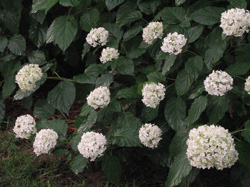Resource Library
Plant of the Week: Hydrangea, Annabelle
The University of Arkansas System Division of Agriculture does not promote, support or recommend plants featured in "Plant of the Week." Please consult your local Extension office for plants suitable for your region.
Plant of the Week
[A-Z]
Annabelle Hydrangea
Latin: Hydrangea arborescens

People who have read these columns for the past decade know I'm fascinated with plant histories. Where did the plant come from and what makes it special? Oftentimes, the stories are lost in the mists of time, but occasionally, they get written down. Such is the case with Annabelle hydrangea, the most beautiful cultivar of our native Hydrangea arborescens.
Wild hydrangea is a native deciduous shrub of the hydrangea family found in moist woodlands from New York to Florida and west to the adjacent corners of Oklahoma and Kansas. It grows 3 to 4 feet tall and spreads slowly sideways from underground stems. Clumps are often several times wider than tall.
What are the characteristics of annabelle hydrangea?
The leaves are dark green, long-petioled and elliptical, in outline, and up to 6 inches long. In the wild, flowers appear in early summer in terminal clusters to 6 inches across. The inflorescence of wildlings consists of a band of dull white showy blossoms surrounding a central field of fertile, petal-less flowers.
But in Annabelle, the flower head consists of all sterile florets, so it has a snowball look. Individual florets are about the size of a dime, but hundreds are produced on the inflorescence. Heads may be as much as a foot across but are typically smaller.
Where did annabelle hydrangea originate?
The story of Annabelle is one of a pass-along plant that was shared by several generations of gardeners before it was "discovered" and made available to the gardening world at large. It hit the nursery trade in 1962, made available by the late J.C. McDaniel, the long time plant breeder and professor of horticulture at the University of Illinois. McDaniel had seen the plant in an Urbana garden in 1960 and traced it back to the southern Illinois farming community of Anna where gardeners grew it all over town.
On enquiry, McDaniel found the plant had been discovered by Harriet Kirkpatrick in 1910. She was riding her horse through the woods of Union County (probably today what is part of the Shawnee National Forest) when she spied the plant and recognized it as something special. Later, she and her sister Amy returned and dug the plant up and took it their garden on Chestnut Street in Anna. McDaniel named the plant for these two belles from Anna.
Harriet's son Hubbard recounted the story of the plant's discovery to McDaniel. He said the family had tried to interest Burpee Seed Company into introducing it, but they opted for an earlier blooming selection called 'Grandiflora,' which they marketed as "Snowhill." Time has proven Annabelle to be the better of the two.
Is annabelle easy to care for?
Annabelle is easy to grow and dependable. It is hardy from zone 4 to 9. It does best in fertile, woodland soil that doesn't get too dry in the summer. It should be in shaded areas of the garden. It will grow in full sun, but like most hydrangeas, it wilts badly during the hottest part of the day.
H. arborescens and its cultivars flower on current season growth, so it's easy to control the size and spread of the plant. Plants can be cut to the ground during the winter and will still flower the following summer. Some recommend cutting the flowers as soon as they begin turning brownish; plants will then produce a second flush of flowers in late summer.
The mature inflorescences are easy to dry for indoor arrangements by stripping the leaves and hanging them upside down in bundles in a cool area. Annabelle is essentially trouble-free in the garden, but some supplemental watering may be needed during dry summers.
By: Gerald Klingaman, retired
Extension Horticulturist - Ornamentals
Extension News - July 3, 2008
The University of Arkansas System Division of Agriculture does not maintain lists of retail outlets where these plants can be purchased. Please check your local nursery or other retail outlets to ask about the availability of these plants for your growing area.